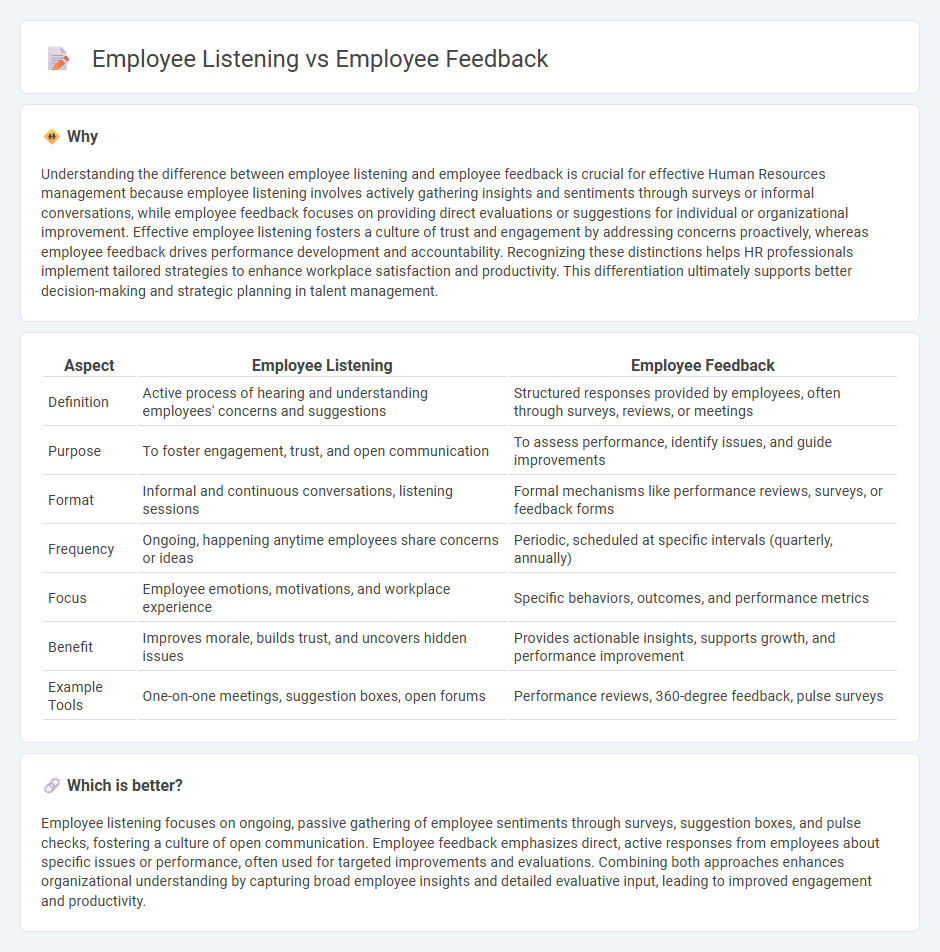
Employee listening involves actively gathering and understanding employees' experiences and sentiments through surveys, interviews, and real-time monitoring tools, focusing on creating a continuous dialogue. Employee feedback refers to the specific responses and opinions provided by employees regarding workplace policies, management, and job satisfaction, often collected periodically. Discover effective strategies to enhance both employee listening and feedback to improve organizational culture and performance.
Why it is important
Understanding the difference between employee listening and employee feedback is crucial for effective Human Resources management because employee listening involves actively gathering insights and sentiments through surveys or informal conversations, while employee feedback focuses on providing direct evaluations or suggestions for individual or organizational improvement. Effective employee listening fosters a culture of trust and engagement by addressing concerns proactively, whereas employee feedback drives performance development and accountability. Recognizing these distinctions helps HR professionals implement tailored strategies to enhance workplace satisfaction and productivity. This differentiation ultimately supports better decision-making and strategic planning in talent management.
Comparison Table
| Aspect | Employee Listening | Employee Feedback |
|---|---|---|
| Definition | Active process of hearing and understanding employees' concerns and suggestions | Structured responses provided by employees, often through surveys, reviews, or meetings |
| Purpose | To foster engagement, trust, and open communication | To assess performance, identify issues, and guide improvements |
| Format | Informal and continuous conversations, listening sessions | Formal mechanisms like performance reviews, surveys, or feedback forms |
| Frequency | Ongoing, happening anytime employees share concerns or ideas | Periodic, scheduled at specific intervals (quarterly, annually) |
| Focus | Employee emotions, motivations, and workplace experience | Specific behaviors, outcomes, and performance metrics |
| Benefit | Improves morale, builds trust, and uncovers hidden issues | Provides actionable insights, supports growth, and performance improvement |
| Example Tools | One-on-one meetings, suggestion boxes, open forums | Performance reviews, 360-degree feedback, pulse surveys |
Which is better?
Employee listening focuses on ongoing, passive gathering of employee sentiments through surveys, suggestion boxes, and pulse checks, fostering a culture of open communication. Employee feedback emphasizes direct, active responses from employees about specific issues or performance, often used for targeted improvements and evaluations. Combining both approaches enhances organizational understanding by capturing broad employee insights and detailed evaluative input, leading to improved engagement and productivity.
Connection
Employee listening and employee feedback are integral components of effective Human Resources management, fostering open communication and trust within the organization. By actively listening to employee feedback, HR professionals gain valuable insights into workplace culture, employee satisfaction, and areas needing improvement, which enhances talent retention and engagement. This feedback loop supports data-driven decision-making, aligning HR strategies with employee needs and organizational goals.
Key Terms
Performance Appraisal
Employee feedback is a structured process where managers provide specific insights during performance appraisals to guide employee development and address skill gaps. Employee listening, however, involves continuous collection of employee sentiments and suggestions through surveys, pulse checks, and open communication channels to foster engagement and improve workplace culture. Explore how integrating these approaches enhances performance appraisals and drives organizational success.
Pulse Surveys
Pulse surveys are brief, frequent tools designed to capture real-time employee feedback and gauge workplace sentiment efficiently. Unlike traditional feedback methods, employee listening via pulse surveys emphasizes continuous engagement and actionable insights that drive organizational improvements. Explore how pulse surveys can transform your employee listening strategy to boost morale and productivity.
Active Listening
Employee feedback involves one-way communication where employees share opinions or concerns, whereas employee listening embodies active listening techniques, emphasizing understanding and responding to employee input. Active listening improves engagement by validating employee voices, fostering trust, and enabling leaders to identify and address underlying issues effectively. Explore strategies to enhance active employee listening and transform workplace communication.
Source and External Links
Employee Feedback Examples: How to Give and Receive It - Employee feedback involves both positive and negative comments aimed at encouraging positive behavior, with examples of how to effectively praise or constructively criticize employees to improve performance and engagement.
32 Employee Feedback Examples for Any Situation - Feedback plays a critical role in employee wellbeing, engagement, and retention by fostering open communication, building trust, and helping companies adapt to workforce needs.
10 Employee Feedback Examples and When to Use Them - Employee feedback is an essential dialogue tool used to align performance with organizational goals, improve productivity, and build a culture of continuous development.
 dowidth.com
dowidth.com